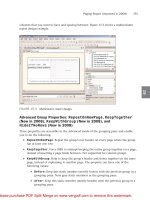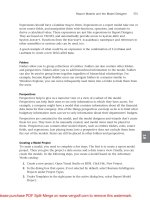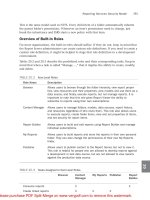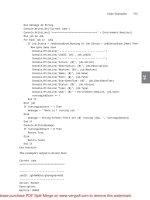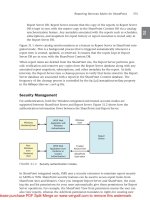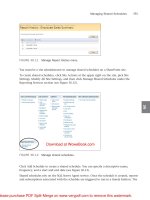Tài liệu Wiley - Microsoft SQL Server 2008 All-in-One Desk Reference For Dummies (2008)02 pdf
Bạn đang xem bản rút gọn của tài liệu. Xem và tải ngay bản đầy đủ của tài liệu tại đây (681.24 KB, 10 trang )
Book I
Chapter 2
SQL Server
Architecture and
Key Concepts
Business Intelligence
19
Business Intelligence
In the not-too-distant past, only the largest enterprises could take advantage
of the proven benefits from complex business intelligence analysis. The soft-
ware and hardware necessary to run these computations was simply out of
reach of most organizations. The past few years have seen the price of hard-
ware and software fall at a steady pace, bringing these kinds of solutions to a
new audience. Microsoft has done its part as well, delivering highly capable
business intelligence technology in conjunction with its database frame-
work. Known as SQL Server Analysis Services, these technologies, which
seamlessly integrate with the Microsoft Office suite, make it possible to
develop and deliver robust analytic solutions without the need for expensive
software and consulting services. Figure 2-3 highlights how, again, the Visual
Studio development environment is the foundation for developing a SQL
Server–related solution. In this case, designing and creating a multidimen-
sional cube.
Figure 2-2:
Creating a
new project
in Visual
Studio.
06_179543-bk01ch02.qxp 8/23/08 12:25 AM Page 19
Reporting
20
Reporting
SQL Server’s Reporting Services (SSRS) aim to offering the IT organization a
single source for creating, maintaining, and delivering reports on information
stored in the database. Well-integrated with Microsoft Office, as well as
SharePoint Server 2007, SSRS reduces the need to purchase and master
third-party reporting solutions. Instead, application designers and develop-
ers can work within the same set of tools to deliver the information their
users require. For example, Figure 2-4 shows the user interface for the
Microsoft Report Designer.
Integration
Several new industries are addressing the ever-multiplying challenges of
tying information together from multiple silos. Unfortunately, from the
perspective of most IT organizations, this leads to purchasing and adminis-
tering an increasing number of integration-related tools. Microsoft has
gotten into the act as well by offering a set of technologies known as SQL
Server Integration Services (SSIS) — a formidable challenger to the Extract,
Transform, and Load (ETL) industry. What’s especially attractive about
Microsoft’s offering is that there’s no additional software to purchase; it’s all
part of SQL Server. It also uses Microsoft’s field-tested approach to solving
complex computing challenges via graphically based (rather than script-
driven) tools. Figure 2-5, which shows the development platform in which
you construct SSIS solutions, illustrates a rich graphical user interface.
Figure 2-3:
Configuring
business
intelligence.
06_179543-bk01ch02.qxp 8/23/08 12:25 AM Page 20
Book I
Chapter 2
SQL Server
Architecture and
Key Concepts
Integration
21
Figure 2-5:
Building an
SSIS
project.
Figure 2-4:
The
Microsoft
Report
Designer.
06_179543-bk01ch02.qxp 8/23/08 12:25 AM Page 21
Book I: Essential Concepts
22
06_179543-bk01ch02.qxp 8/23/08 12:25 AM Page 22
Chapter 3: Getting Started,
Getting Around
In This Chapter
ߜ Hardware and software requirements
ߜ Converting to SQL Server 2008
ߜ Tools at your disposal
I
f you’re ready to get started on the road to a fully functional SQL Server
environment, this chapter is for you. We get the ball rolling by telling you
about the hardware and software foundations that you need to install the
product. The next task is to examine what it takes to either upgrade from an
earlier version of SQL Server or convert from an entirely different database
platform. The chapter closes by taking you on a brief tour of the excellent
tools included with SQL Server, along with some examples of situations
where you’re able to put them to work.
Hardware and Software Requirements
Although you might be tempted to pop in the DVD containing the SQL
Server software, or point your browser at Microsoft’s Web site and then
immediately download and install the product, take a few minutes and
determine whether your computer meets some minimal requirements.
Otherwise, you might find that your installation efforts are for naught or
that your SQL Server instance runs poorly (or not at all!). Fortunately, as
the next chapter illustrates, Microsoft thoughtfully includes a system
configuration check utility as part of the SQL Server installation. However,
you can pass this test and still have a sluggish system, which is why you
want to pay attention to the recommendations listed in this chapter.
Note: If you’re curious about the installation experience, the next chapter
gives that topic the rich treatment it deserves.
Take the time to go through each of these major system readiness categories,
making sure that you meet or exceed each of these prerequisites. Also, if
you’re installing SQL Server on multiple machines, remember that a machine
acting as a central server will generally require faster and better hardware
than one that primarily acts as a client. Finally, you need to have administra-
tive privileges on the computer where you’re installing SQL Server.
07_179543-bk01ch03.qxp 8/23/08 12:26 AM Page 23
Hardware and Software Requirements
24
✦ CPU: To keep things moving, you need a CPU with at least a Pentium III-
class processor running at a minimum of 1 GHz. For serious work, plan
on employing a Pentium IV processor that offers at least 2 GHz.
✦ Memory: Because sufficient memory serves as the foundation of any
well-performing relational database, make sure that you provide 1GB or
more. Generally, just as you can’t be too rich or too thin, you can’t pro-
vide a relational database with too much CPU or memory; SQL Server
will always use as much memory as it needs but not more.
✦ Disk: Given that relational databases use disk drives as their primary
storage mechanism, it’s always difficult to recommend a fixed value for
the right amount of available disk capacity — every site and application
is different. However, note that a full installation of SQL Server and
related tools eats more than 2GB before any of your data arrives.
SQL Server ships in several editions for both 32- and 64-bit platforms. This
can affect the exact hardware and software configuration that you need. In
general, “more and faster” is better.
✦ Operating system: Microsoft gives you a fairly wide choice of operating
systems (both 32-bit and 64-bit) that can run SQL Server. They include
• Windows Server 2008 (Standard, Data Center, Enterprise)
• Windows Server 2003 (Standard, Data Center, Enterprise)
• Windows XP Professional Edition
• Windows Vista (Ultimate, Home Premium, Home Basic, Enterprise,
Business)
Be prepared to apply the latest service pack for your operating system;
in many cases, SQL Server depends on these patches.
✦ Supporting software: Because it’s built on top of some of Microsoft’s
newest technologies, SQL Server requires that you install some addi-
tional software components. These can include
• .NET Framework 2.0
• SQL Server Native Client
• SQL Server Setup support files
• Windows Installer 3.1
• Microsoft Data Access Components (MDAC) 2.8 SP1 or newer
• Internet Explorer SP1 or newer
SQL Server’s installation logic is quite sophisticated; it generally obtains
these components automatically for you as part of the installation
process, assuming you’re connected to the Internet.
07_179543-bk01ch03.qxp 8/23/08 12:26 AM Page 24
Book I
Chapter 3
Getting Started,
Getting Around
Converting to SQL Server 2008
25
Converting to SQL Server 2008
Unless you’re building a brand new set of applications, chances are you
have an existing database that will need to be converted to work with SQL
Server 2008. This section shows you how to handle this important task.
We’ve broken this portion into two segments: converting from an earlier
version of SQL Server, and converting from a different relational database
management system.
Before undertaking any major system or software upgrade, it’s always wise
to perform a complete backup of your information. The data you save may
be your own!
Upgrading from earlier versions of SQL Server
Upgrading database software (and the data contained in it) is always a
nerve-wracking experience. Luckily, if you’re running an earlier instance of
SQL Server (such as SQL Server 2000 or 2005), it’s actually quite simple. You
can even elect to have your SQL Server 2008 instance simultaneously run-
ning alongside the earlier edition.
Assuming that you want to upgrade the entire instance, here’s how to get
started:
1. Obtain a copy of the product.
Most database administrators obtain a physical DVD containing the SQL
Server product; there are also circumstances where it’s available elec-
tronically. If you obtain a physical copy, place the media in your com-
puter’s DVD drive.
2. Launch the SQL Server setup application.
The Setup.exe file is under the \Servers folder on your installation
media.
3. Accept the license terms and click Next.
The installation program obtains any necessary supporting software.
4. Select the Upgrade from SQL Server 2000 or 2005 option in the SQL
Server 2008 Installation Center dialog box.
The System Configuration Checker analyzes your computer to see if it’s
capable of running SQL Server 2008. If any problems occur, you’re
alerted here.
5. Choose the instance you want to upgrade and click Next.
You can also instruct SQL Server on whether you want to upgrade the
entire instance or just its shared components. Figure 3-1 shows how this
dialog box appears:
07_179543-bk01ch03.qxp 8/23/08 12:26 AM Page 25
Converting to SQL Server 2008
26
6. Review the features that will be upgraded and click Next.
Figure 3-2 shows the list of features that are being upgraded.
7. Configure the accounts you want to run the SQL Server services and
click Next.
8. When prompted, fill in details about how you want errors handled,
and click Next.
Figure 3-2:
Selecting
features.
Figure 3-1:
Selecting an
instance to
upgrade.
07_179543-bk01ch03.qxp 8/23/08 12:26 AM Page 26
Book I
Chapter 3
Getting Started,
Getting Around
Converting to SQL Server 2008
27
9. Run the Upgrade Rules Check wizard.
SQL Server now executes a rules engine to ensure that your existing
instance can be upgraded.
10. Review the Ready to Upgrade page, and click Next.
After you’ve given it the go-ahead, SQL Server upgrades your database
to SQL Server 2008. You can monitor how things are going by watching
the Progress page.
After the conversion is complete, you need to do a few more things to finish
the job, including:
✦ Refreshing usage counters.
✦ Updating statistics. Book VII, Chapter 1 is where you can find out how to
address these first two topics.
✦ Registering your servers. Check out Book IV, Chapter 6 for more about
distributed environments.
✦ Adjusting your configuration. Book VIII, Chapter 1 shows you how to
tweak your SQL Server configuration.
✦ Rebuilding your full-text catalogs. Book III, Chapter 8 includes an
explanation of the care and feeding of SQL Server’s full-text search
capabilities.
On the other hand, if all you want to do is copy a database from an earlier
version of SQL Server into a new instance, you can use the Copy Database
Wizard to accomplish this task. Book VIII, Chapter 2 explains how to copy,
export, and import databases.
Converting from a different database
Normally, the mere thought of converting between relational database
platforms is enough to send shivers up the spine of even the most hardened
database administrator. Fortunately, SQL Server 2008 offers several simple
yet powerful tools to make migrating data less of a burden. I’ll briefly
describe two of these tools, along with criteria you can use to pick one
of them.
SQL Server Import and Export Wizard
This utility (launched by right-clicking on the Management folder within the
SQL Server Management Studio and selecting the Import Data menu option)
allows you to import information easily into your new SQL Server instance.
It’s quite flexible and simple to use, and as shown in Figure 3-3, you can bring
in data from a broad range of information storage formats, including:
07_179543-bk01ch03.qxp 8/23/08 12:26 AM Page 27
Converting to SQL Server 2008
28
✦ ODBC
✦ Oracle
✦ SQL Server
✦ Flat files
✦ Microsoft Access
✦ Microsoft Excel
If your existing database is on this list, then it’s likely that this is the right
tool to use to import information into SQL Server. Book VIII, Chapter 2
explores this topic in more detail.
SQL Server Integration Services
These components are much more powerful, but significantly more complex
to employ. They make it possible for SQL Server administrators and integra-
tion specialists to connect to and manipulate just about any data format out
there. Figure 3-4 offers a brief glimpse into the kinds of sophisticated integra-
tion workflow available to you. Generally, if you’re faced with a more com-
plex or ongoing integration scenario, it’s worthwhile to get to know this
extremely capable technology.
Figure 3-3:
Available
data source
formats
from the
SQL Server
Import and
Export
Wizard.
07_179543-bk01ch03.qxp 8/23/08 12:26 AM Page 28
